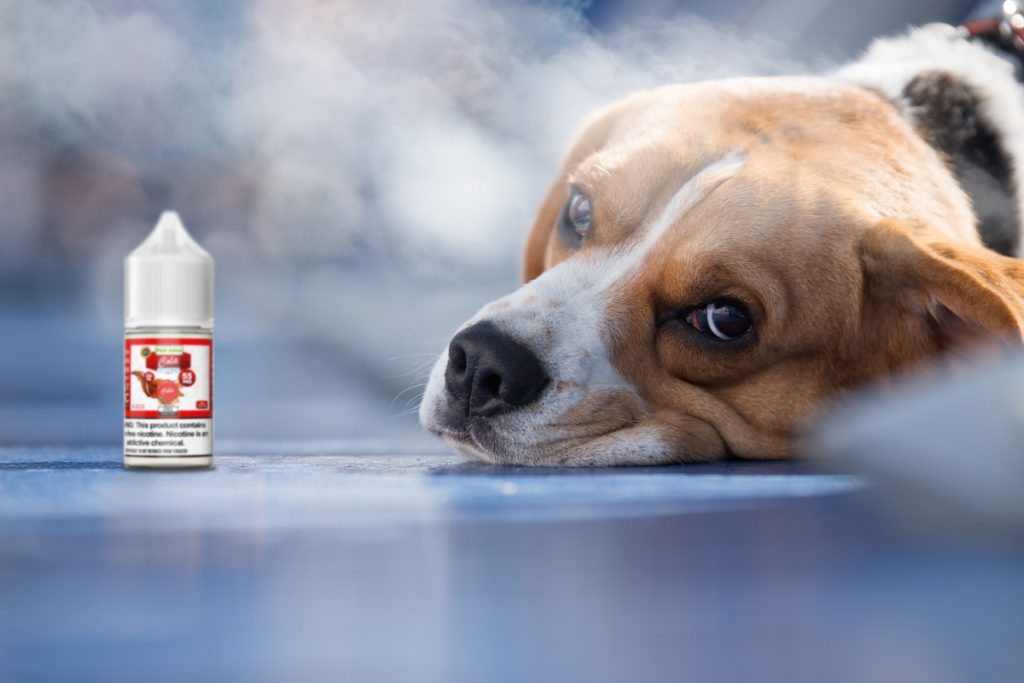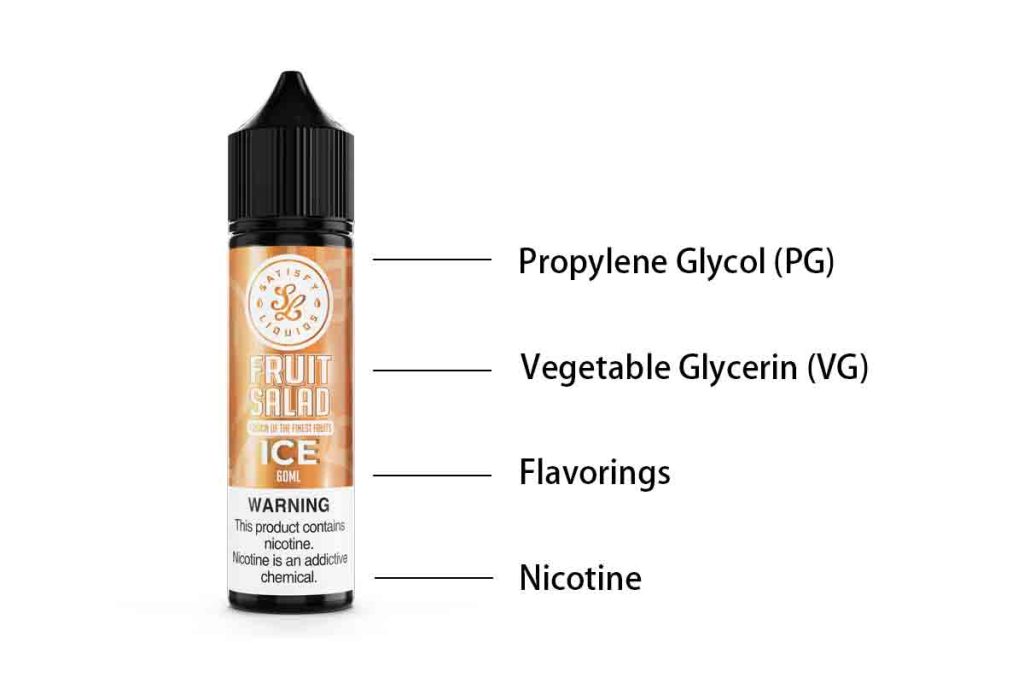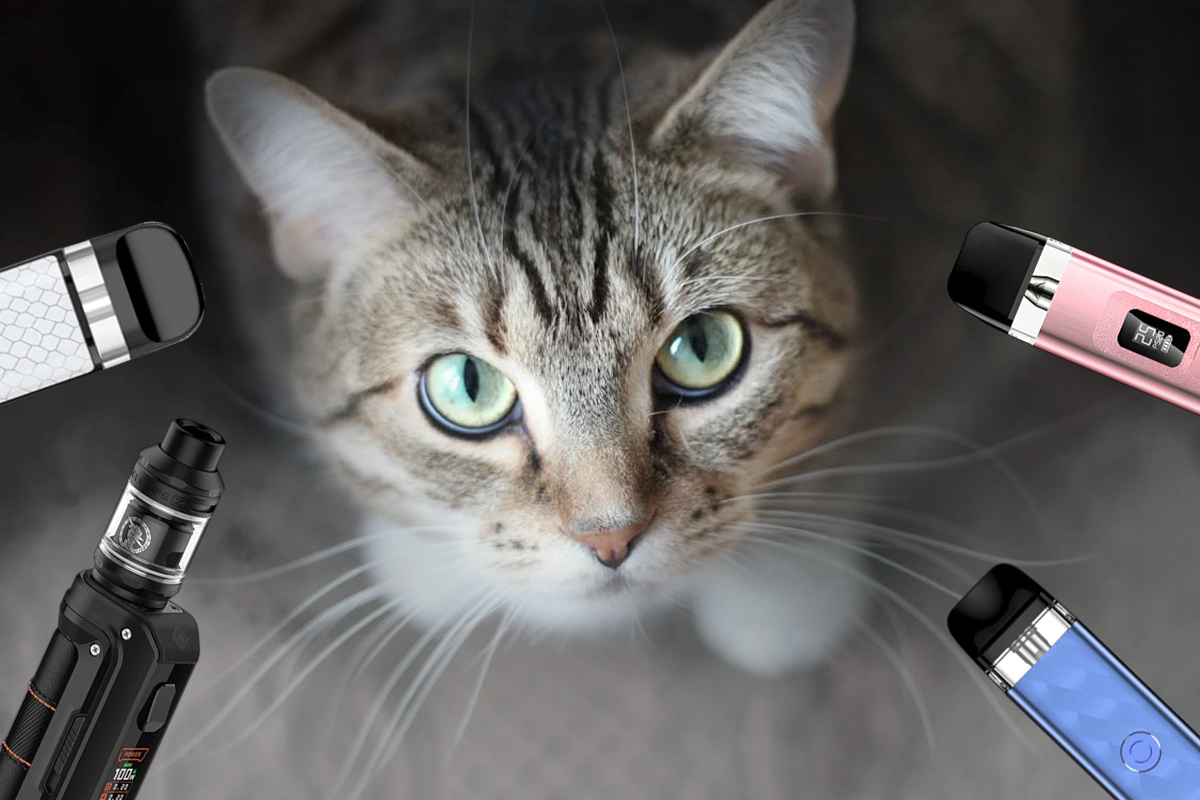Does a Dog Get High from Vape Smoke? A Comprehensive Guide for Pet Owners
In an age where vaping has become a common sight, a crucial question often arises for devoted pet owners: “Does a dog get high from vape smoke?” As you relax with your vape, you may notice your furry companion nearby and wonder about the safety of your habit. This article aims to provide a clear, evidence-based answer to that pressing question. While dogs do not experience a “high” in the same euphoric sense as humans, the reality is that exposure to vape smoke is far from harmless. In fact, it can be incredibly dangerous. We will delve into the multifaceted risks your dog faces from vape smoke, from the psychoactive components like THC to the often-overlooked toxic chemicals in e-liquids. Our goal is to equip you with the knowledge to protect your beloved pet in a world where vaping is increasingly prevalent.
II. Deconstructing the “High”: How Vaping THC Affects Dogs Differently Than Humans

Does a Dog Get High From Vape Smoke Containing THC? The Surprising and Dangerous Reality.
The concept of a dog getting “high” from THC-containing vape smoke is a significant and dangerous misconception. While THC is the compound that produces a psychoactive effect in humans, its impact on dogs is vastly different and profoundly negative. This is largely due to the differences in our biological makeup, specifically the endocannabinoid system.
Dogs possess a higher concentration of cannabinoid receptors in their brains than humans, particularly in areas that control coordination and balance. This heightened sensitivity means that even a small amount of THC can be toxic to them. Instead of a pleasurable “high,” dogs experience a state of distress and poisoning. The symptoms of THC toxicity are a clear indication of this adverse reaction and can be frightening for both the pet and the owner.
The signs of THC toxicity in dogs can manifest within 30 minutes to a few hours of exposure and can last for up to 72 hours. These symptoms include:
- Ataxia: A staggering, “drunk-like” walk and loss of coordination.
- Urinary Incontinence: Involuntary dribbling of urine is a hallmark sign.
- Vomiting: The body’s attempt to expel the toxin.
- Disorientation and Confusion: Your dog may seem lost or unresponsive.
- Hypersalivation: Excessive drooling.
- Vocalization: Whining, crying, or uncharacteristic barking.
- Lethargy or Agitation: A drastic change in energy levels.
- Increased Sensitivity: Startling easily at movements or sounds.
- Dilated Pupils: Unusually large pupils.
- In severe cases, THC toxicity can lead to tremors, seizures, and even a comatose state.
It is crucial for pet owners to understand that any exposure to THC-containing vape smoke is a medical emergency for their dog.
III. The Invisible Threat: The Dangers of Secondhand and Thirdhand Vape Smoke for Your Dog
Beyond the “High”: How Secondhand and Thirdhand Vape Smoke Harms Your Dog.
The dangers of vaping around your dog extend far beyond the immediate effects of THC. The aerosol produced by e-cigarettes, often mistakenly called vapor, poses a significant threat through both direct and indirect exposure.

A. The Dangers of Secondhand Vape Aerosol:
Secondhand vape smoke is the aerosol that is exhaled by the user. This is not harmless water vapor; it’s a mixture of fine and ultrafine particles containing nicotine, volatile organic compounds (VOCs), and other harmful chemicals. When a dog inhales this aerosol, these particles can penetrate deep into their sensitive respiratory system. This can lead to:
- Respiratory Irritation: Causing coughing, wheezing, and shortness of breath.
- Exacerbation of Existing Conditions: For dogs with conditions like asthma or bronchitis, exposure can trigger severe attacks.
- Allergic Reactions: Some dogs may develop allergic reactions to the chemical components, leading to skin irritation, itching, and respiratory distress.
B. The Hidden Dangers of Thirdhand Vape Residue:
Thirdhand vape smoke is the toxic residue that settles on surfaces long after the visible aerosol has dissipated. This sticky film clings to everything in the environment, including your dog’s fur, bedding, toys, and food and water bowls. The primary mode of exposure for dogs is through ingestion when they groom themselves or lick contaminated objects. This chronic, low-level exposure can lead to:
- Oral Cancers: As cats who groom themselves in smoking households have a higher risk of oral tumors, a similar risk is posed to dogs from thirdhand vape residue.
- Long-Term Health Risks: The accumulation of toxic chemicals in your dog’s system can contribute to the development of various cancers and other chronic diseases over time.
IV. Nicotine Poisoning: A Severe and Rapid Threat from Vape Smoke and E-Liquids
Does a Dog Get High From Nicotine Vape Smoke? The Lethal Truth About Nicotine Poisoning.
While the question of a “high” is often linked to THC, nicotine-containing vapes present a far more immediate and potentially lethal threat to dogs. Nicotine is a potent neurotoxin for canines, and even small amounts can lead to severe poisoning. According to the American Lung Association, a lethal dose of nicotine for most dogs is between 9-12 mg/kg.
Exposure can occur through the inhalation of nicotine-laced vape smoke, but the most severe cases of poisoning happen when a dog ingests e-liquid. The sweet smells of flavored vape juices can be enticing to a curious dog, leading them to lick up spills or chew on discarded cartridges. A single e-liquid cartridge can contain anywhere from 6 to 24 mg of nicotine, enough to be fatal to a small dog.

Symptoms of nicotine poisoning can appear within 15 to 60 minutes of exposure and include:
- Vomiting and diarrhea
- Agitation, restlessness, or hyperactivity
- Elevated heart rate and blood pressure
- Panting and difficulty breathing
- Excessive drooling
- Tremors and seizures
- Weakness and collapse
- In severe cases, cardiac arrest and death.
If you suspect your dog has been exposed to nicotine in any form, it is a critical emergency requiring immediate veterinary attention.
V. The Toxic Brew: Unpacking the Harmful Ingredients in E-Liquids
More Than Just Vapor: The Toxic Ingredients in E-Liquids That Can Harm Your Dog.

Beyond THC and nicotine, the base components of e-liquids themselves can pose a risk to your dog’s health.
- Propylene Glycol (PG): This common ingredient in e-liquids is categorized as “generally recognized as safe” for dogs in small, ingested amounts by the FDA. However, the Pet Poison Helpline notes that the inhalation of large amounts of concentrated PG from vape smoke can be problematic. While cats are particularly sensitive to PG, which can cause a serious blood disorder, high-level exposure in dogs can also lead to health issues.
- Vegetable Glycerin (VG): Generally considered safe for dogs to ingest in small quantities, large amounts of ingested VG can lead to digestive upset, such as diarrhea.
- Flavoring Agents and Other Additives: The long-term effects of inhaling the myriad of food-grade flavorings used in e-liquids are largely unknown for both humans and pets. It’s also crucial to be aware that some sweeteners, like xylitol, are extremely toxic to dogs. While not typically found in vapes, this highlights the importance of keeping all non-pet-safe products away from your dog.
VI. The All-Natural Myth: Are Essential Oil Vapes a Safe Alternative Around Dogs?
“Natural” Doesn’t Mean Safe: The Dangers of Essential Oil Vapes for Your Dog.
Some pet owners may turn to essential oil vapes or diffusers, believing them to be a safer, “all-natural” alternative. However, this is a dangerous misconception. A dog’s respiratory system and sense of smell are thousands of times more sensitive than a human’s. Many essential oils that are pleasant and even beneficial to humans are toxic to dogs.
According to Coralville Animal Hospital, oils such as tea tree, pine, wintergreen, cinnamon, citrus, peppermint, and ylang-ylang are toxic to pets whether they are applied to the skin, ingested, or inhaled via a diffuser or vape. The tiny droplets dispersed by these devices can cause aspiration pneumonia and other toxic effects. Symptoms of essential oil toxicity can include respiratory distress, drooling, vomiting, and neurological signs like stumbling or tremors. It is always best to consult a veterinarian before using any essential oils around your pets.
VII. Proactive Protection: How to Keep Your Dog Safe from Vape Smoke
Protecting Your Furry Friend: Practical Steps to Prevent Your Dog from Getting Harmed by Vape Smoke.
The best way to protect your dog is through prevention. Here are some actionable steps you can take:
- Create a Vape-Free Zone: The safest approach is to never vape indoors or in enclosed spaces where your dog is present. If you vape, do so outside and away from your pet.
- Secure Storage: Always store your vaping devices, e-liquids, and cartridges in a locked cabinet or a location that is completely inaccessible to your dog.
- Safe Disposal: Dispose of used cartridges and empty e-liquid bottles securely to prevent your dog from finding them in the trash.
- Ventilation is Key: If vaping indoors is unavoidable, ensure maximum ventilation by opening windows and using high-quality air purifiers.
- Wash Your Hands: After vaping, wash your hands thoroughly with soap and water before petting your dog to prevent the transfer of thirdhand smoke residue.
- Observe Your Pet: Be vigilant for any changes in your dog’s health or behavior that could indicate a problem.
VIII. Emergency Plan: What to Do if You Suspect Your Dog Has Been Exposed to Vape Smoke or E-Liquid
Urgent Action: A Step-by-Step Guide if Your Dog is Exposed to Vape Smoke or E-Liquid.
If you suspect your dog has ingested e-liquid or is showing signs of toxicity from vape smoke, time is of the essence.
- Immediate Veterinary Contact: Immediately call your veterinarian or a pet poison control center like the Pet Poison Helpline or the ASPCA Animal Poison Control Center.
- Provide Information: Be prepared to tell the veterinarian the type of vape product, the ingredients (if known), the amount of potential exposure, and your dog’s approximate weight.
- Do Not Induce Vomiting Unless Instructed: In some cases, inducing vomiting can be dangerous. Always follow the specific advice of a veterinary professional.
- Follow Veterinary Advice: Adhere strictly to the veterinarian’s instructions for the best possible outcome for your pet.
IX. Conclusion: Prioritizing Your Dog’s Health in a Vaping World
The answer to “Does a dog get high from vape smoke?”
is a definitive no. Instead, they are at risk of being poisoned. From the neurotoxicity of THC and nicotine to the respiratory damage from secondhand smoke and the hidden dangers of thirdhand residue, vaping poses a significant and multifaceted threat to our canine companions. Responsible pet ownership means protecting them from these preventable dangers. By taking the necessary precautions, you can ensure that your home remains a safe and healthy environment for your beloved dog.
X. Frequently Asked Questions (FAQs)
Your Questions Answered: FAQs About Dogs and Vape Smoke.
- Can a dog get high from secondhand vape smoke? No, dogs do not get “high” from secondhand vape smoke. Instead, they can experience toxic effects that lead to illness. The symptoms can range from respiratory irritation to severe poisoning, depending on the substances in the vape smoke.
- How long do the effects of vape smoke last in a dog? The duration of the effects depends on the substance (THC or nicotine), the level of exposure, and the size of the dog. Symptoms of THC toxicity can last for 24 to 72 hours, while the acute and dangerous symptoms of nicotine poisoning can appear within an hour and may require immediate and intensive veterinary care.
- Is it illegal to vape around your dog? While there are no specific laws that make it illegal to vape around your dog, causing harm to an animal through such exposure could potentially be prosecuted under animal cruelty or neglect laws in some jurisdictions.
- What are the long-term effects of vape smoke on dogs? The long-term effects of chronic exposure to vape smoke on dogs are still being studied, but potential risks include chronic respiratory conditions like asthma and bronchitis, persistent allergies, and an increased risk of developing certain types of cancer, similar to the risks associated with secondhand tobacco smoke.
- Can vape smoke kill a dog? Yes, vape smoke and its associated products can be fatal to a dog. Ingesting e-liquid containing nicotine can cause rapid and severe poisoning that can lead to death. High doses of THC can also cause life-threatening complications.
- Are there any dog-safe vapes? No, there are no “dog-safe” vapes. All forms of vaping produce aerosols and contain chemicals that can be harmful to a dog’s sensitive system. The only truly safe approach is to keep all vape products and smoke away from your pets.






